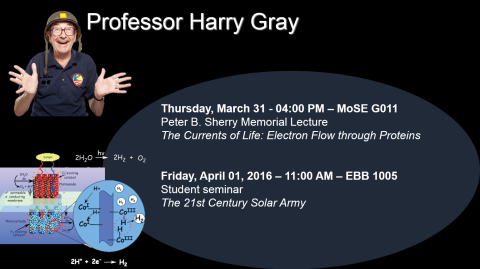event
Peter B. Sherry Memorial Lecture
Primary tabs
The Currents of Life: Electron Flow through Proteins
Biological electron transfers often occur between metal-containing cofactors that are separated by very large molecular distances. Understanding the underlying physics and chemistry of these long-range electron transfer processes is the goal of much of the work in my laboratory.
Employing laser flash-quench triggering methods, my coworkers and I have shown that 2-nm, coupling-limited Fe(II) to Ru(III) and Cu(I) to Ru(III) electron tunneling reactions in Ru-modified cytochromes and blue copper proteins occur on microsecond to nanosecond timescales. We also have demonstrated that redox equivalents can be transferred even longer distances by multistep tunneling (hopping) through intervening tyrosines and tryptophans: notably, in work on cytochrome P450 and azurin, we have found that long-range hole hopping through intervening tryptophans can be orders of magnitude faster than single-step tunneling.
Could hole hopping through Tyr/Trp chains protect redox enzymes from oxidative damage? We think so! By examining the structures of P450 and related enzymes, we have identified candidate Tyr/Trp chains that could transfer holes from uncoupled high-potential intermediates to cellular reductants in contact with protein surface sites.
Groups
Status
- Workflow status: Published
- Created by: A. Maureen Rouhi
- Created: 03/30/2016
- Modified By: Fletcher Moore
- Modified: 04/13/2017
Categories
Keywords
Target Audience

